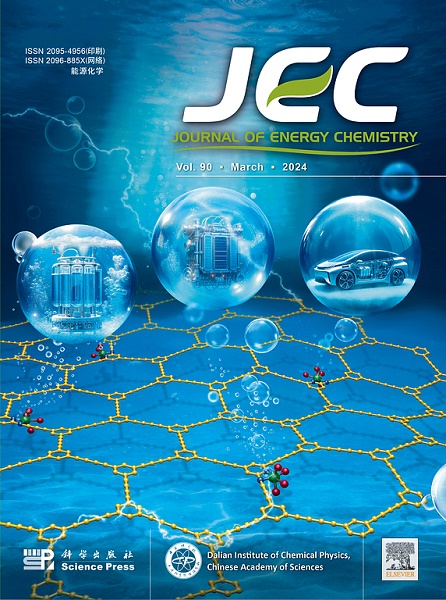Highly ionic conductive composite membrane electrolyte with vertically aligned structure and radial gradient copolymer for high-performance solid-state lithium metal batteries
IF 13.1
1区 化学
Q1 Energy
引用次数: 0
Abstract
Solid-state polymer electrolytes are crucial for advancing solid-state lithium-metal batteries owing to their flexibility, excellent manufacturability, and strong interfacial compatibility. However, their widespread applications are hindered by low ionic conductivity at room temperature and lithium dendrite growth. Herein, we report a novel solid-state composite membrane electrolyte design that combines the vertically aligned channel structure and copolymer with a radial gradient composition. Within the vertically aligned channels, the composition of poly(vinyl ethylene carbonate-co-poly(ethylene glycol) diacrylate) (P(VEC-PEGDA) varies in a gradient along the radial direction: from the center to the wall of vertically aligned channels, the proportion of vinyl ethylene carbonate (VEC) in the copolymer decreases, while the proportion of poly(ethylene glycol) diacrylate (PEGDA) increases accordingly. It can be functionally divided into a mechanical-reinforcement layer and a fast-ion-conducting layer. The resulting solid-state composite membrane electrolyte achieves a high critical current density of 1.2 mA cm−2 and high ionic conductivity of 2.03 mS cm−1 at room temperature. Employing this composite membrane electrolyte, a Li//Li symmetric cell exhibits stable cycling for over 1850 h at 0.2 mA cm−2/0.2 mA h cm−2, and a Li//LiFePO4 (LFP) battery maintains 77.3% capacity retention at 2 C after 300 cycles. Our work provides insight into the rational design of safer and more efficient solid-state batteries through electrolyte structural engineering.

具有垂直排列结构和径向梯度共聚物的高性能固态锂金属电池用高离子导电复合膜电解质
固态聚合物电解质由于其灵活性、优异的可制造性和强大的界面兼容性,对固态锂金属电池的发展至关重要。然而,它们的广泛应用受到室温下低离子电导率和锂枝晶生长的阻碍。在此,我们报告了一种新型的固态复合膜电解质设计,它结合了垂直排列的通道结构和具有径向梯度组成的共聚物。在垂直排列的通道内,聚碳酸乙烯乙烯-共聚乙二醇二丙烯酸酯(P(VEC-PEGDA))的组成沿径向呈梯度变化:从垂直排列的通道中心向壁面,共聚物中碳酸乙烯乙烯(VEC)的比例降低,聚乙二醇二丙烯酸酯(PEGDA)的比例相应增加。它在功能上可分为机械增强层和快速离子传导层。在室温下,该固态复合膜电解质的临界电流密度为1.2 mA cm - 2,离子电导率为2.03 mS cm - 1。使用这种复合膜电解质,锂/锂对称电池在0.2 mA cm - 2/0.2 mA h cm - 2下稳定循环超过1850 h,锂//LiFePO4 (LFP)电池在300次循环后在2℃下保持77.3%的容量保持率。我们的工作通过电解质结构工程为更安全、更高效的固态电池的合理设计提供了见解。
本文章由计算机程序翻译,如有差异,请以英文原文为准。
求助全文
约1分钟内获得全文
求助全文
来源期刊

Journal of Energy Chemistry
CHEMISTRY, APPLIED-CHEMISTRY, PHYSICAL
CiteScore
19.10
自引率
8.40%
发文量
3631
审稿时长
15 days
期刊介绍:
The Journal of Energy Chemistry, the official publication of Science Press and the Dalian Institute of Chemical Physics, Chinese Academy of Sciences, serves as a platform for reporting creative research and innovative applications in energy chemistry. It mainly reports on creative researches and innovative applications of chemical conversions of fossil energy, carbon dioxide, electrochemical energy and hydrogen energy, as well as the conversions of biomass and solar energy related with chemical issues to promote academic exchanges in the field of energy chemistry and to accelerate the exploration, research and development of energy science and technologies.
This journal focuses on original research papers covering various topics within energy chemistry worldwide, including:
Optimized utilization of fossil energy
Hydrogen energy
Conversion and storage of electrochemical energy
Capture, storage, and chemical conversion of carbon dioxide
Materials and nanotechnologies for energy conversion and storage
Chemistry in biomass conversion
Chemistry in the utilization of solar energy
 求助内容:
求助内容: 应助结果提醒方式:
应助结果提醒方式:


